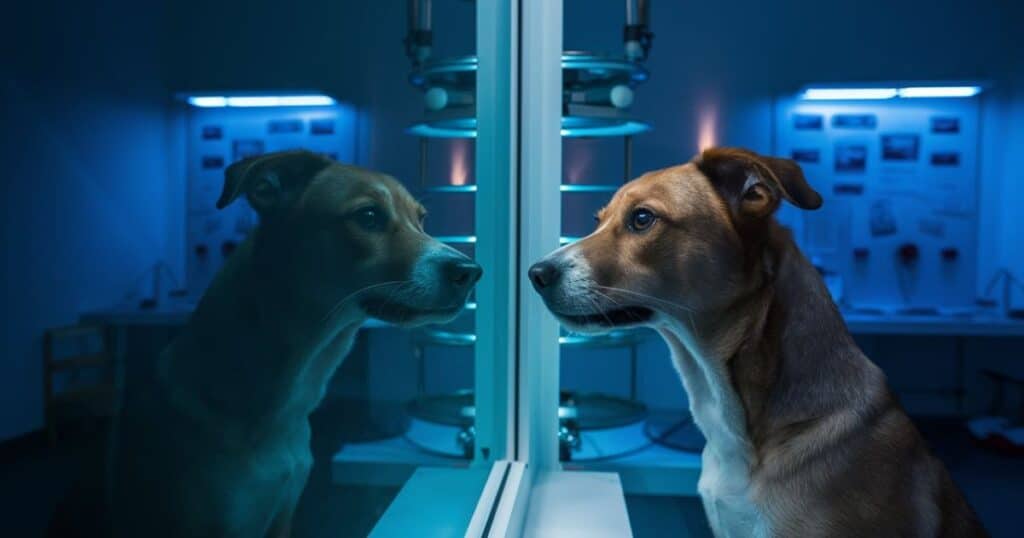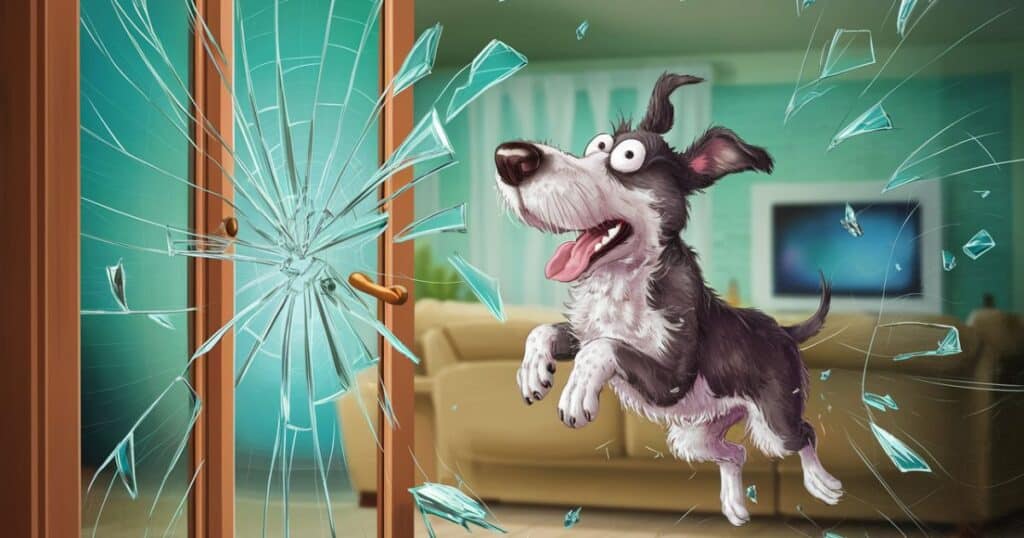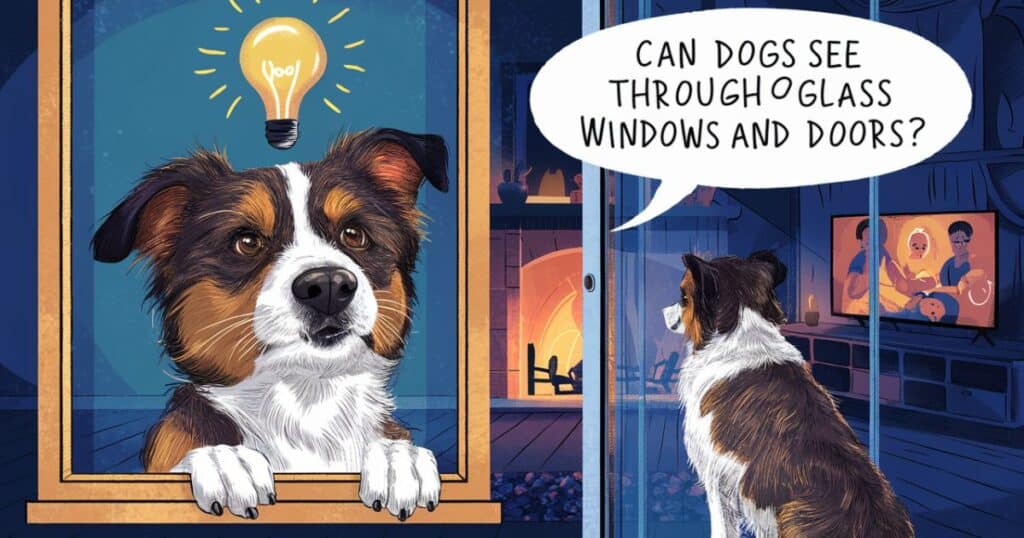Ever caught your furry friend staring intently through a window, seemingly lost in thought? You might’ve wondered, “What’s going on in that fuzzy head?” Well, you’re not alone. Many dog owners find themselves pondering this very question: can dogs see through glass windows and doors? It’s a fascinating topic that delves into the world of canine perception and how our four-legged companions interact with their environment.
In this comprehensive guide, we’ll explore the ins and outs of dogs’ vision, particularly when it comes to transparent surfaces. We’ll uncover the similarities and differences between human and canine sight, dive into the science behind a dog’s ability to perceive glass, and even touch on how their other senses come into play. So, grab a cup of coffee, curl up with your pup, and let’s embark on this eye-opening journey!
So Can Dogs See Through Glass Like Humans Can?
Let’s cut to the chase – yes, dogs can indeed see through glass, much like we humans do. But before you start planning a canine art gallery tour, it’s important to note that their perception isn’t exactly the same as ours.
Dogs, like humans, can perceive the transparency of glass. This means they can see objects, people, or other animals on the other side of a window or glass door. However, their interpretation of what they’re seeing might differ from ours in several ways:
- Depth perception: Dogs have less precise depth perception than humans, especially at close range. This can sometimes lead to misjudgments when approaching glass surfaces.
- Color vision: While not colorblind, dogs see fewer colors than humans. This might affect how they perceive objects through glass, especially if the glass has a slight tint.
- Visual acuity: Dogs have lower visual acuity than humans, meaning their vision isn’t as sharp as ours. Think of it as watching a slightly fuzzy TV screen.
Let’s break it down with a quick comparison:
| Aspect | Human Vision | Dog Vision |
| Color perception | Full color spectrum | Dichromatic (mainly blues and yellows) |
| Visual acuity | 20/20 (standard) | 20/75 (approximate) |
| Depth perception | Excellent | Good, but less precise at close range |
| Night vision | Limited | Superior |
Despite these differences, dogs are generally quite adept at navigating their environment, including areas with glass barriers. They learn from experience and use their other senses to supplement their vision.
MORE POST: Can Dogs Eat Cinnamon Toast Crunch Safely?
Why Dogs Can See Through Glass
To understand why dogs can see through glass, we need to take a quick dive into the world of optics. Glass is transparent because it allows light to pass through it with minimal absorption or scattering. This property is what enables both humans and dogs to see through it.
A dog’s eye, like a human’s, is designed to capture light and convert it into electrical signals that the brain can interpret as images. The basic structure of a dog’s eye includes:
- Cornea: The clear outer layer that helps focus light.
- Pupil: The adjustable opening that controls how much light enters the eye.
- Lens: Focuses light onto the retina.
- Retina: Contains photoreceptors (rods and cones) that convert light into electrical signals.
When light passes through a glass window or door, it travels relatively unimpeded into the dog’s eye, allowing them to perceive what’s on the other side. However, there are some limitations to a dog’s glass perception:
- Reflections: Strong reflections on glass surfaces can confuse dogs, just as they can confuse humans.
- Cleanliness: A dirty or smudged glass surface might be more noticeable to dogs due to their keen sense of smell.
- UV sensitivity: Dogs can see some ultraviolet light, which might make certain types of glass appear slightly different to them than to us.
“Dogs’ ability to see through glass is a testament to the remarkable adaptability of their visual system,”
says Dr. Ellen Furlong, animal cognition expert at Illinois Wesleyan University.
Can Dogs See Through Glass at Night?

Night time brings a whole new dimension to the question of canine glass perception. Dogs, as it turns out, have a significant advantage over humans when it comes to low-light vision. This superiority stems from several adaptations in their eyes:
- Larger pupils: Dogs’ eyes can dilate more than humans’, allowing more light in.
- More rods: The retina contains more rod cells, which are responsible for detecting light and motion.
- Tapetum lucidum: This reflective layer behind the retina enhances night vision by reflecting light back through the retina a second time.
These adaptations mean that dogs can indeed see through glass at night, often much better than we can. However, the effectiveness of their night vision through glass can be affected by several factors:
- Interior lighting: Bright lights inside can create reflections on the glass, potentially obscuring the view outside.
- Exterior lighting: Street lamps or moonlight can enhance a dog’s ability to see through glass at night.
- Glass quality and cleanliness: Smudges or low-quality glass might impact visibility more at night.
To help your dog navigate glass barriers in low light:
- Keep windows and glass doors clean
- Use window treatments to reduce glare from interior lights
- Consider adding subtle markers to glass doors to prevent collisions
Do Dogs Understand What Glass Is?
Now, here’s where things get really interesting. While dogs can see through glass, their understanding of it as a concept is quite different from ours. Dogs don’t have the abstract thinking capabilities to understand glass as a man-made, transparent solid. Instead, they learn about glass through experience and association.
Many dog owners have witnessed the comical (and sometimes concerning) sight of their pup running full-tilt into a glass door. This isn’t because the dog can’t see the glass, but because they haven’t yet learned that it’s a solid barrier.
Research into canine cognition regarding transparent barriers has yielded some fascinating insights:
- A study published in the journal “Animal Cognition” found that dogs can learn to respect the boundaries of a glass barrier after repeated exposure.
- Another experiment showed that dogs were more likely to attempt to pass through a transparent barrier to reach a treat than an opaque one, suggesting they struggle with the concept of transparent solids.
“Dogs live in a world of smells first, sights second. The idea of a visual barrier that doesn’t have a corresponding scent barrier is likely confusing to them.”
Dr. Alexandra Horowitz, author of “Inside of a Dog,” notes.
Over time, most dogs learn to navigate their environment, including glass barriers, through a combination of visual cues, scent, and past experiences. But it’s safe to say their understanding of glass is more practical than conceptual.
Understanding a Dog’s Vision
To truly grasp how dogs perceive glass, we need to take a deeper look at canine vision overall. While dogs and humans both rely heavily on sight, there are some key differences in how our eyes work.
Eye Structure
A dog’s eye is structurally similar to a human’s, but with some crucial differences:
- Retina composition: Dogs have more rod cells (good for detecting motion and working in dim light) and fewer cone cells (responsible for color vision and detail).
- Lens position: A dog’s lens sits further back in the eye, creating a larger cornea and allowing more light to enter.
- Field of view: Dogs have a wider field of view (250° compared to humans’ 180°) but less binocular vision.
Color Perception
Contrary to popular belief, dogs aren’t colorblind in the traditional sense. They’re dichromats, meaning they have two types of cone cells instead of the three that humans have. This results in color vision similar to what a red-green colorblind human might experience.
Dogs see primarily in blues and yellows, with greens, yellows, and reds appearing more yellowish. This means that while they can see through glass, the world on the other side might look a bit different to them than it does to us.
Visual Acuity
When it comes to visual acuity (the clarity or sharpness of vision), dogs fall short of humans. While a human with perfect vision has 20/20 acuity, dogs typically have vision closer to 20/75. This means that what a human can see clearly at 75 feet, a dog would need to be at 20 feet to see with the same clarity.
However, dogs excel in other areas:
- Motion detection: Dogs are highly attuned to movement, even at great distances.
- Peripheral vision: Their wider field of view allows them to detect movement on the edges of their vision more easily than humans.
- Night vision: As mentioned earlier, dogs see much better in low light conditions.
Understanding these aspects of canine vision helps explain why dogs interact with glass the way they do. They can see through it, but their perception of what’s on the other side might be less detailed and differently colored than what we see.
Other Senses Dogs Use To Recognize Glass Windows and Doors
While vision plays a crucial role in how dogs interact with glass, it’s not the only sense they rely on. Dogs are sensory powerhouses, and they use a combination of their keen senses to navigate their environment, including areas with glass barriers.
The Sense of Smell
A dog’s sense of smell is legendary, estimated to be anywhere from 10,000 to 100,000 times more powerful than a human’s. This olfactory prowess plays a significant role in how dogs perceive glass barriers:
- Scent markers: Dogs can detect the scents of people, animals, or objects that have come into contact with the glass.
- Air currents: Even through sealed windows, dogs can often smell what’s on the other side due to tiny air leaks.
- Material odors: The glass itself, as well as window frames and sealants, have distinct scents that dogs can identify.
This powerful sense of smell helps dogs understand the presence of a barrier even when it’s visually transparent. It’s why your dog might bark at a closed window – they can smell something interesting on the other side!
The Sense of Hearing
Dogs’ hearing is also far superior to humans’, capable of detecting a much wider range of frequencies and quieter sounds. This auditory acuity contributes to their perception of glass in several ways:
- Sound reflection: Glass surfaces reflect sound differently than open spaces, helping dogs identify their presence.
- Vibrations: Dogs can detect subtle vibrations in glass caused by sound waves or movement.
- Outside noises: Even through closed windows, dogs can hear outdoor sounds that might not be audible to humans.
A dog might cock its head when looking through a window not just because of what it sees, but also what it hears. The combination of visual, olfactory, and auditory information helps dogs build a complete picture of their environment, including the presence and nature of glass barriers.
The Dangers of Dogs and Glass Doors

While dogs can generally navigate their environment well, including areas with glass, there are potential hazards to be aware of. Glass doors, in particular, can pose risks if dogs haven’t learned to recognize them or if the doors aren’t properly marked.
Common accidents involving dogs and glass include:
- Collisions: Dogs running into glass doors, especially if they’re chasing something or excited.
- Scratching: Some dogs may scratch at glass doors, potentially causing injury to their paws.
- Anxiety: Clear glass can sometimes cause anxiety in dogs if they can see something they want to get to but can’t reach.
To prevent these issues and keep your furry friend safe, consider the following tips:
- Add visual markers: Apply decals, stickers, or frosted patterns to glass doors at your dog’s eye level.
- Use sound cues: Train your dog to associate a specific sound with the presence of a closed glass door.
- Provide alternatives: If your dog often wants to look outside, consider providing a designated, safe spot for them to do so.
- Regular cleaning: Keep glass surfaces clean to reduce confusing smudges or marks.
- Supervision: Always supervise young dogs or new pets until they’re familiar with the layout of your home.
“Prevention is key when it comes to glass-related injuries in dogs,” “Taking simple precautions can save both you and your pet from stress and potential harm.”
advises Dr. Jerry Klein, Chief Veterinary Officer of the American Kennel Club.
Final Thoughts On if Dogs Can See Through Glass Windows, Doors, and Double Glazing
As we’ve explored throughout this article, the answer to “Can dogs see through glass windows and doors?” is a resounding yes – but with some fascinating caveats. Dogs possess the ability to perceive through transparent surfaces, much like humans do. However, their unique sensory makeup and cognitive processes mean they interact with glass in ways that might seem puzzling to us.
Let’s recap the key points:
- Dogs can see through glass, but their visual perception differs from humans in terms of color, acuity, and depth perception.
- Canine night vision is superior to humans’, allowing them to see through glass even in low light conditions.
- While dogs can see through glass, they don’t understand it conceptually the way humans do.
- Dogs use a combination of vision, smell, and hearing to navigate environments with glass barriers.
- Glass doors can pose potential hazards for dogs, but these can be mitigated with proper precautions.
Understanding how your dog perceives and interacts with glass can help you create a safer, more comfortable environment for them. It can also deepen your appreciation for their unique way of experiencing the world.
As a dog owner, you can use this knowledge to:
- Enhance your dog’s safety around glass surfaces
- Understand and address behaviors related to windows and glass doors
- Provide enriching experiences that cater to your dog’s sensory abilities
Remember, every dog is unique, and they may interact with glass differently based on their individual experiences and personality. Take the time to observe your own dog’s behavior around glass surfaces. You might be surprised by what you learn!
By understanding the intricacies of canine perception, we can strengthen our bonds with our furry companions and ensure they navigate our glass-filled world with ease and confidence. After all, seeing the world through our dogs’ eyes (or noses, or ears!) can lead to a whole new level of understanding and appreciation for these remarkable animals.
ALSO READ THIS POST: Why Does My Dog Sit Alone In Another Room?
FAQ’s
Can my dog see me through the window?
Yes, your dog can see you through the window. Dogs have the ability to perceive through transparent surfaces like glass, though their visual acuity isn’t as sharp as humans’. They may also use other senses like smell and hearing to detect your presence.
Can animals see through glass?
Most animals with developed eyesight can see through glass, including mammals, birds, and many reptiles. However, their perception may differ from humans due to variations in color vision, visual acuity, and depth perception. Some animals might not fully understand the concept of a transparent barrier.
Can dogs see through screen doors?
Dogs can generally see through screen doors, as the mesh is designed to allow visibility. However, the screen might slightly blur their view, especially if it’s darker inside than outside. Dogs often rely on their sense of smell and hearing in conjunction with vision when it comes to screen doors.
Can dogs see out of tinted windows?
Dogs can see out of tinted windows, but their view may be affected depending on the level of tint. Darker tints might make it more challenging for dogs to see clearly, especially in low light conditions. However, their superior night vision may compensate for this to some extent.
Can dogs see through glass windows?
Yes, dogs can see through glass windows. Their ability to perceive through transparent surfaces is similar to humans, though their visual interpretation may differ due to their unique color perception and lower visual acuity. Dogs often combine visual cues with scent and sound to understand what’s beyond the glass.
How to make a screen door dog proof?
To make a screen door dog proof, consider installing a sturdy pet screen made of durable materials like vinyl-coated polyester. Add a protective grille or guard to the lower portion of the door. You can also train your dog to respect the barrier and provide alternative ways for them to view or access the outdoors.

Davin Connor is an experienced author with 3 years in pets writing. Known for concise, informative content, he shares expertise on pet care, behavior, and health through his engaging articles.






